|
| |
|
|
| |
 |
Completions to the study of the thin frame overprint "Gültig 9. Armee", 1917-1918 |
 |
|
 |
Recently I had the opportunity to aquire the largest known multiple for the Romanian 1 Leu revenue stamp (King Charles) with "Gültig 9. Armee" overprint in thin frame: a big block of 46 stamps (almost a whole sheet, printing plate contains 50 stamps***). It is a beautiful item for my exhibit, which provides also answers regarding the plating of the overprint (Photo 1).
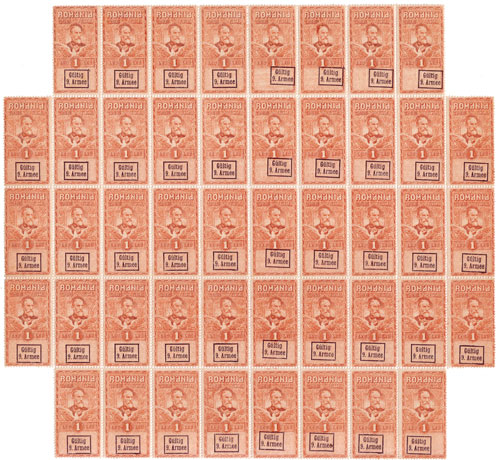 Photo 1
Photo 1
|
I have also smaller multiples of the overprinted revenue stamp (blocks of 8, 12 or 16 stamps, even a large block of 40). Studying them, I saw a lot of varieties of the overprint, but till now I couldn't make a connection between them. I have studied all known published studies, but no one stated how was made overprinting and how were made the printing plates. There is also a lack of informations regarding the dates of issue and withdraw of these stamps.
Historical considerations
Very briefly, because the subject has been treated by other authors.
At the end of 1916, the Central Powers armies occupied a large part of territory of Romania. On July 10th, 1917 (date revised - June 1, 1917, War Issue No. 165, Bukarester Tagblatt 148/May 31, 1917*****), by order of the Military Administration established rules, and postal rates. Compared to the rest of the occupied territory under the Military Administration of Romania (MViR), a territory that included the area near the front (including the counties of Buzau, Ramnicu Sarat, Putna, and Braila) entered in the administration of the 9th Army. City of Focsani (administrative center of County Putna) came under German occupation from December 25, 1916 and would be released only on November 10th, 1918. Here was established the headquarters of the 9th Army. 1st Army Corps commander was General Kurt von Morgen (*).
In terms of revenue taxes, things moved faster. Thus, since January 1917, the German Military Administration of Romania followed the Romanian Adoption Laws from February 4th, 1906 and December 24th, 1914 (with associated fees, however modified), begun the overprinting of the revenue stamps, and compulsory stamps with MViR overprint (***). In the 9th Army area, a forerunner of the overprinted stamps with "Gültig 9. Armee", appears in Focsani (where was the headquarter of the commander of the 9th Army) a provisional issue of revenues with overprint "Steuermarke / gueltig fur / 1. Res - Korps /" has appeared, with face values of 10 bani, 30 bani, 1 leu and 5 lei. They are listed in the Romanian Revenue Stamps Catalogue, 2011, published by Eng Mihai Cojocar, Various Issues chapter, page 249, but there are not so many details (*).
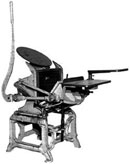
Photo 2
|
The author has in his collection the earliest usage date of a revenue stamp overprinted "Gültig 9. Armee" in thick frame, October 13th, 1917 (*). This usage is extremely important, since the literature does not specify an exact date of issue, noting only the years 1917/1918. Further, one can assume that the stamps with "Gültig 9. Armee" overprint with thick frame have been issued for the needs of the 9th Army and the overprint could be made locally, for replacing the provisional local issue in Focsani. But there are some interesting questions. Why were the revenues used only in Focsani? Why were the 30 bani revenue stamps overprinted with "M.V.i.R" in double vertical frame, then overprinted again with "Gültig 9. Armee" in thick frame, (5 items reported so far, one has "dropped 9"***), then used only in Ramnicu-Sarat, Buzau and Braila? Why was modified the overprint afterwards? Why was used the new overprint (with thin frame) on "Germania" stamps, for postal service?
The overprinting
For fiscal needs, new revenue stamps were printed in Bucharest, with the old printing plates used for the previous issues as well. After that, these revenue stamps were overprinted with "M.V.i.R.". Before overprinting, the sheet margins were removed. There is no overprinted revenue stamp reported with attached sheet margin (corner). The printing sheets of 10 Bani, 30 Bani, 1 Leu and 5 Lei revenues have 50 stamps, and the sheet of the 10 Bani help ("Ajutor") has 100 stamps. For 2 Lei help stamp there are not large blocks reported, but I suppose that the overprinted sheets had 100 stamps as well.
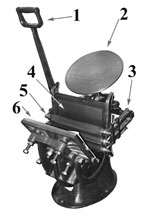
Photo 3
|
The earliest date of tax use reported for the overprint "Gültig 9. Armee" in thin frame is December 13th, 1917, in Focsani. There are very few known documents, and the number of remaining unused multiples (even pairs) is too small for a comprehensive study. The latest known date for stamps with overprint in thick frame is August 24th, 1918 (a document from Braila), and for stamps with overprint in thin frame is March 23th, 1919 (on a document from Buzau). These revenues were withdrawn with a delay of 30 days, under the Decree Law No.868 (February 25th, 1919 (***). Almost all overprinted revenues were used for real in Focsani, Ramnicu-Sarat, Buzau and Braila. The remaining unused revenue stamps were used on philatelic covers and postcards, being cancelled either with fake postmarks, or with real BUKAREST cancellation (with earlier usage dates), they do not conform with postal rates or with the real purpose of the revenue stamps.
In my previous study I have described how were made the clichés of the overprint, using single letters and numbers, separated by blank spaces. After positioning, all the stuff was fixed inside a marginal necklaces (**). This system generated a lot of varieties, uneven settings and certain damages of some letters or frames (the "dropped 9" variety is a good example). For overprinting there were used small printing presses, maybe Heidelberg or Boston-Tiegel for small formats of the paper sheets (Photo 2, 3, 4).
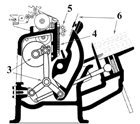
Photo 4
|
The total amount of printing runs were not so big. Because of the different sizes of the stamps to overprint, I guess there was not made a special zinc plate for each size, but the ensemble of separate letters, numbers and blank spaces was kept together. It was modified by inserting different blank spaces for each size of the stamp to overprint. Three different settings were used: one for the 10 Bani "Ajutor" stamp, one for the 10 Bani revenue stamp and another for the 30 Bani, 1 Leu and 5 Lei revenue stamps. Certain varieties of the overprint can be found on 10 Bani multiples, but further research have to be done for this stamp. For the other stamps, same setting of the overprints with thin frame can be found on each face value.
As I mentioned before, there is a possibility that the "Gültig 9. Armee" overprint with thick frame was applied at Focsani (it is not known for sure, further research is needed). Today, one can notice a very small number of real used stamps, compared with those unused. This ratio leads to a certain difficulty to localize the overprinted stamps. This is one reason that made me to wait for further discoveries. What I've already seen is the fact that the "dropped 9" error can be found in four different combinations at least, so the statement that there are two errors like this in a printing sheet might not be true. So, keeping in mind all the characteristics met for this overprint, I found a regular repeat of its settings as shown:
| 1 |
2 |
3 |
4 |
5 |
6 |
7 |
8 |
9 |
10 |
|
9 |
10 |
|
1 |
2 |
3 |
x |
x |
1 |
2 |
3 |
| 11 |
12 |
13 |
14 |
15 |
16 |
17 |
18 |
19 |
20 |
|
9 |
10 |
|
4 |
5 |
6 |
x |
x |
4 |
5 |
6 |
| 1 |
2 |
3 |
4 |
5 |
6 |
7 |
8 |
9 |
10 |
|
9 |
10 |
|
7 |
8 |
9 |
x |
x |
7 |
8 |
9 |
| 11 |
12 |
13 |
14 |
15 |
16 |
17 |
18 |
19 |
20 |
|
9 |
10 |
|
10 |
11 |
12 |
x |
x |
10 |
11 |
12 |
| 1 |
2 |
3 |
4 |
5 |
6 |
7 |
8 |
9 |
10 |
|
9 |
10 |
|
13 |
14 |
15 |
x |
x |
13 |
14 |
15 |
| |
|
|
|
|
|
|
|
|
|
|
9 |
10 |
|
|
|
|
|
|
|
|
|
The case for the other type of overprint seems to be easier, (maybe due to my last finding), I'll explain later. But let us see an overview of the overprinting process first.
The Boston-Tiegel machines could print small format works, headers for companies, small calendars, labels, invitations, postcards and other small format paper and low circulation. Work processes and handling are simple and can execute even a child. The first step is of course collecting form of printing and mounting them in the framework [4] (Photo 5, 6, 7). Then mount the frame on the machine, location guides on the port paper board [6] (Photo 8), mixing ink paste and its application on the turntable [2] (Photo 9, 10) and, finally, start the machine. The two to three rubber rolls [5] (Photo 11) handle operated [1] or by eccentric shaft with pedal [3], cross the frame framework is loaded with ink on the upper turntable, turn over frame by submitting framework equal ink over printed form. When the rollers down as printing, paper is pressed onto the mounting plate as the printing and then removed before the next race up the rolls. The process takes a few seconds, the operator can replace paper or stamps on paper plate port (Photo 12). Then repeat the same operations. The main steps are reproduced below and you can see the online videos (****).
 |
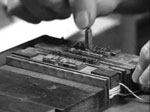 |
 |
 |
| Photo 5
|
Photo 6
|
Photo 7
|
Photo 8
|
 |
 |
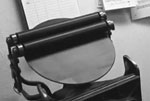 |
 |
| Photo 9
|
Photo 10
|
Photo 11
|
Photo 12
|
|
Because of the human factor, it happens that stamps may be placed skews or offset from the original markings. This creates gaps, slopes and evidence of overprinting "in pieces". The sheet I referred in the beginning was placed in three different operations in the printing press. The left half of the sheet has the cliché of the overprint in a straight,
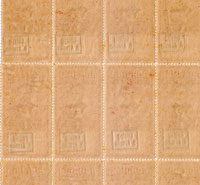
Photo 13
|
vertical position. On the right half of the sheet, it is bent to the right with 1.56 degrees.
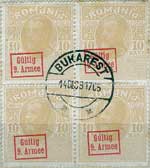
Photo 14
|
On the other face of the sheet, one could see the entire cliché in blind impression (without the black ink, in German is named "Blinddruck"), being also bent to the right, but only 1.14 degrees (Photo 13).
A possible explanation for this can be that the operator forgot to put ink, the machine worked with sheet of paper already set in the guides, machine has done his duty and printed overprint, but pressing them like an embossed paper. The operator has observed the error and the performed the overprinting process again, this time with ink on the plate. Then he moved the sheet of paper and printed the other half of the sheet. Let's see some other examples of this process (Photo 14, 15).
I've studied a lot of small and large blocks for different face values. What I can tell is that I've noticed certain characteristics for each of the 25 overprints, which were used as a compact group (one can associate them with a transfer block). Some of these micro signs can be seen easier, others cannot. But despite all of this, the order of each individual overprint in the block of 25 remains the same. Sometimes, for some singles it is difficult to identify its position. Besides, I've met large blocks of the 10 Bani "Ajutor" stamps where the "duck beak" variety is missing, maybe the deformed frame was repaired or maybe it was replaced, but all other characteristics are present. For this 10 Bani stamp, sometimes the micro signs are hard to distinguish, due to its dull violet-brown color. That is why one can use a image processor software for searching the micro signs. In this way some elements can be better observed, a magnifying glass is useless.
Reconstructing the overprinting plate
In the reproduction above the shown the report of 25 cliches, with arrows to the specifics micro signs. Should however note that there are several factors that can make identifying the position in earnings. Paper type (plain or coated) wear to each cliché, the amount of ink applied to overprint, all they can sometimes make it impossible to determine the position (for singles).

Photo 16
|
Here, briefly, the main features of clichés:
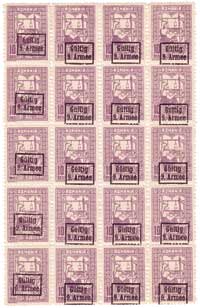 Photo 15
Photo 15
|
1. ü left foot elongated; deformed t; A slightly deformed; frame line left / right top small beaks.
2. duck beak right corner (at most 10 bani revenue stamps is missing); cross shorter than t; r flattened loop; left frame cracks.
3. beak low right corner, and external point; l knock up; A clogged; r bent almost stuck loop m; the last eis elongated.
4. top right corner separated; short and deformed t; r loop curved; ü beaks first small point almost glued; mid-line frame cracked right down.
5. frame line separated the top right bottom left; A clogged sometimes;ü points and the top tilted to the right; r small loop; the last e is clogged.
6. frame corners slightly flared; short cross t; l footed; ü right foot short; small loop r.
7. beak up and point right outside; A clogged, the last e is elongated; weak slash between 9 and point; g with the stem up.
8. right frame corners top and bottom; ü or missing apparently first point; g loop clogged and the stem below the horizontal; A clogged; l no beak; short loop r.
9. frame corners right up and down and left down; ü the first point apparently; l little or no beak; r short loop; m loop back below and feet flat; 9 crooked or deformed; i small point; A with feet almost stuck.
10. lower left frame line; A clogged (not all) and deformed right; right angle r; point out the lower right frame corner; ü higher point on the right; between l and t weak slash down.
11. between the beak G and beak ü an apparent oblique stroke sometimes pronounced; sometimes A and ee clogged; ü second point angle and lower; the lower left corner inside broken frame; point outside the line left in the right frame of 9.
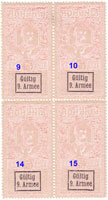
Photo 19
|
12. lines at the corners frame left / right corner and bottom right slightly separated; flattened loop r; 9 hunched and deformed;
13. ü points almost glued; g the stem short; A clogged (not all); r united to m by thin line; m below the second loop; 9 with back straight
14. beak slightly outside the upper left corner frame; small angle t; r almost stuck m; mee cracked diagonally; left frame line thinned and damaged inner frame bottom left corner.
15. bottom right frame line swelling outside; right lateral line e damaged and left damaged in the 9; 9 hunched; A right foot.
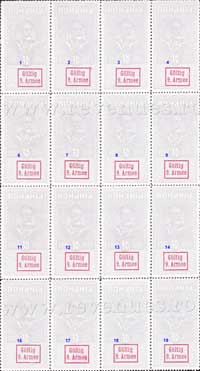
Photo 18
|
16. hit line bottom left side of the frame; bottom right frame line disruptions inside; r loop and short beak.
17. t cross small; flattened loop r; ü deformed right leg; mee cracked diagonally; left and bottom right corner cracks.

Photo 17
|
18. ü second point angle (not all); 9 deformed foot (sometimes sticking point with him); r loop and short beak; sometimes color point outside corner right framework.
19. A median tipped split and mee diagonally cracked; broken leg ü (sometimes filled with color); moved slightly inside the left frame corner; comma after 9 instead of point.
20. top right corner cut out frame; frame up clogged line outside the left half (waves); line the bottom right frame slightly swollen; 9 twisted down the back.
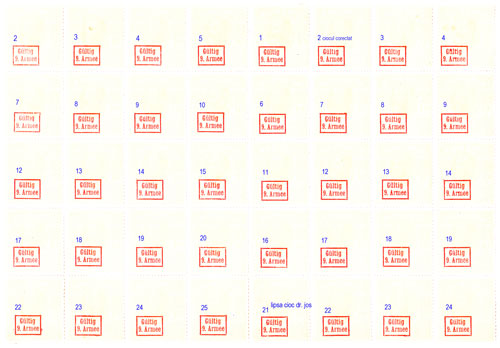
Photo 20
|
21. beak small frame top right corner; lower right frame corner broken slash inside and outside; ü apparently the first point; line interrupted below the bottom frame.
22. beak small frame top right corner; ü apparently the first point; m twisted the right side; line up with the waves outside left frame; bottom broken line inside the left frame.
23. frame line clogged up outside (waves); line thickened outer bottom right frame.
24. top right frame corner cut out (sometimes to the beak); ü missing first point (sometimes apparently); A dirty; clogged left outer frame line below; m almost glued soles.
25. beak prominent top right corner frame; frame bottom right corner cut out.
Bibliography:
* The first revenue issue, of the 9th Army area management, Adrian Apostu, http://www.revenues.ro;
** The revenue and assistance stamps with the "Gültig 9. Armee" overprint, Marian Jianu şi Francisc Ambruş, FILATELIA, Nr.9/2008; http://www.revenues.ro;
*** Romania, specialized catalogue of revenue stamps, 1872-1919, Francisc Ambruş 2010.
**** The Letterpress Revival, Letterpress Printing, Letterpress printing @ Myrtle Alley Press, Antique Letterpress demonstration, http://www.youtube.com/
***** Die Landespost im besetzten Rumänien, Franz Josef Mutter; Tarifele, taxele şi gratuităţile poştale în România 1841-2008, vol. 2, Călin Marinescu; Die Eröffnung der Landespost in Rumänien, Kriegsausgabe No 165, Bukarester Tagblatt, no. 148, 31 Mai 1917.
Francisc Ambruş, 07/2012
|
 |
|
|
|

